高斯无奇点卫星运动方程的数学推导
——谨以本文恭贺师兄欧吉坤教授七十寿辰
2015-05-08许国昌沈云中蒋春华
许国昌,陈 武,沈云中,江 楠,蒋春华
高斯无奇点卫星运动方程的数学推导
——谨以本文恭贺师兄欧吉坤教授七十寿辰
许国昌1,2,陈 武3,沈云中4,江 楠5,1,蒋春华1
(1.山东大学 空间科学研究院,山东 威海 264209;2.中国空间技术研究院 中国航天钱学森实验室,北京 100094; 3.香港理工大学,中国 香港 999077;4.同济大学 测绘与地理信息学院,上海 200092;5.柏林工业大学,德国 柏林 10623)
本文给出高斯无奇点运动方程的严格数学推导。该方程的无奇点特性使轨道力学中的奇点问题获得了完全的解决。
天体力学;解析方法;奇点问题;高斯无奇点运动方程;拉格朗日无奇点运动方程
0 引言
牛顿在1687年首先在其著作数学原理中提出万有引力和运动方程[1-5]。其后,天体力学和N体问题的理论研究主要基于拉格朗日方程和源于拉格朗日方程的高斯方程[6-10]。奇点问题一直是天体力学和N体问题研究中的核心问题之一[11-16]。人们为理论研究进展作了很多努力[17-24]。卫星轨道理论研究主要基于二体问题的摄动理论[31-39]。二阶摄动理论解研究近年来有了系统的进展[26-28,30],所以奇点问题的解决成为迫切的需要。无奇点理论2012年以不定积分的解的形式提出[29]并于2013年有了以微分方程描述的版本[25]。但其公式推导主要是逻辑推理,2014年有了拉格朗日无奇点运动方程纯数学的严格具体的证明推导[40]。本文给予高斯无奇点运动方程纯数学的严格具体的证明推导。
1 高斯无奇点运动方程的数学推导
拉格朗日无奇点运动方程的数学推导已在文献[40]中详细给出。高斯运动方程的推导的基础是拉格朗日运动方程,其推导可以在很多文献[24-25]中找到,为了获得优化的推导公式,直接从拉格朗日无奇点运动方程开始。
拉格朗日无奇点运动方程[40]即Lagrange-Xu运动方程为
(1)
(2)
(3)
(4)
(5)
(6)

R对各轨道根数的偏导数为[24]:
(7)

(8)

(9)

(10)

(11)
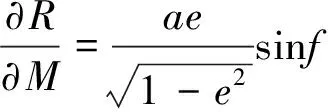
(12)
式(7)~式(12)中fa、fh、fr分别表示轨道坐标系的摄动力分量。轨道参数之间还有关系
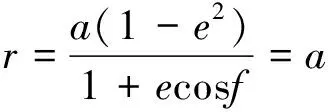
(13)
rcosf=a(cosE-e)
(14)
(15)
式(13)~式(15)中E为偏近点角。下面我们分别将式(7)~式(15)代入无奇点拉格朗日运动方程式(1)~式(6)来推导高斯无奇点方程。
将式(12)代入式(1),可得

(16)
将式(11)、式(12)代入式(2)得

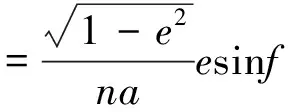

(17)


(18)


(19)
否则,
(20)
或者表示成
(21)
将式(10)、式(11)代入式(4)得:

(22)
将式(9)代入式(5),同理
(23)


(24)
则
(25)



(26)

(27)
(28)
(29)

(30)
(31)
(32)
式(27)~式(32)即为无奇点的高斯运动方程,亦称无奇点的Gauss-Xu方程。上述推导数学上是严格的。
2 与原始高斯方程的比较
与如下原始高斯卫星运动方程相比[19-20,32,35,37,40]


(33)
很容易注意到原高斯方程仅适用于非奇异情形。而无奇点的高斯方程即Gauss-Xu方程式(27)~式(32)则一般地成立,且不存在奇异的可能性。式(27)与式(33) 的第一个方程相同,因其不会奇异。式(28)与式(30)实际上可以直接从式(33)中的第二个和第四个方程通过把奇异因子e和 sini从右侧移到左侧而获得。
3 与文献[25]的比较
高斯运动方程可作如下变形:

(34)
文献[25]将高斯方程式(34)改写成[25,29]


(35)
式(35)中,δ及其下标表示式(34)的右边各项。式(35)中的第二和第六个方程乘以e,第四个和第五个方程乘以sini,第三个方程乘以esini,有


(36)
式(36)是无奇点的 (n在第六个方程中被忽略)。解 (即式 (35) 的不定积分) 可用类似于[21,26-28]的方法获得且有形式


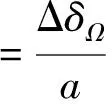

(37)
式(37)中,右侧Δy表示y的不定积分,左侧Δx表示dx/dt的不定积分,x表示开普勒轨道根数。
则无奇点的高斯方程的解为
Δa=Δδa

Δcosi=-siniΔδi
(38)
基本高斯运动方程被定义为[26,40]
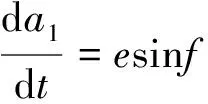
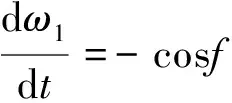

(39)
由式(38) 和式(39)可得


(40)
同上,分别对式 (40) 条件做进一步的推导,据定义[26]
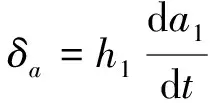
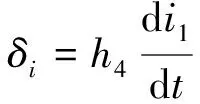
(41)
由式(41) 和 (34),条件if(Δδω2,sini)则等价于if(δω2,sini),

(42)
故if(Δδω2,e)的等价条件为:if(fh,sini)。
条件if(Δδω1,e)则等价于if(δω1,e),

(43)
故if(Δδω1,e)的等价条件为:if(fa,e)∧if(fr,e)。
若if(ΔδΩ,sini)则等价于if(δΩ,sini),

(44)
故if(ΔδΩ,sini)的等价条件为:if(fh,sini)。
若if(ΔδM2,e)则等价于if(δM2,e)

(45)
故if(ΔδM2,e)的等价条件为:if(fa,e)∧if(fr,e)
则式(40)可以写成
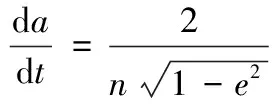

(46)
式(46)与高斯无奇点运动方程式(27)到式(32)除微小差别(式(46)中最后一式n被忽略)外,完全一致。
4 结束语
卫星轨道无奇点运动方程的正确性通过严格
的数学证明予以证实。同时高斯—许方程被以严格的数学方法获得再次推导。
致谢:本研究受山东大学和中国空间技术研究院支持并部分地获得山东大学学科建设经费和国家自然科学基金的资助。第二、三作者参与了本文有关的有价值的讨论。第四、五作者分别就理论公式做了推导和验证。
[1] NEWTON I.Philosophiae Naturalis Principia Mathematica[M].London:[s.n.],1687.
[2] GOLDSTEIN H.Classical Mechanics[M].2nd ed.New York:Addison-Wesley,1980.
[3] LANDAU L D,LIFSHITZ E M.MECHANICS[M].3rd ed.New York:Pergamon Press,1976.
[4] EULER L.Proprietates Triangulorum,Quorum Anguli Certam inter se Rationem Tenent[J].Novi Commentarii Academiae Scientiarum Imperialis Petropolitanae,1767,10:207-242.
[5] LAGRANGE J L.Motion for Three Bodies[J].Miscellanea Taurinensia,1772,4:118-243.
[6] TISSERAND F F.Mecanique Celeste,Tome III[M].Paris:[s.n.],1894:27.
[7] HAGIHARA Y.Celestial Mechanics[M].[ S.l.]:MIT Press,1970.
[8] MITTAG-LEFFLER G.The N-body Problem (Price Announcement)[M].[ S.l.]:Acta Matematica,1885/1886:7.
[9] POINCARE H.New Methods of Celestial Mechanics[M].[ S.l.]:AIP,1992.
[10] BARROW-GREEN J.Poincare and the Three Body Problem[M].[ S.l.]:American Mathematical Society,1996.
[11] XIA Zhi-ling.The Existence of Noncollision Singularities in Newtonian System[J].Annals Math.1992,135(3) 411-468.
[12] SUNDMAN K F.Mémoire sur le Problème des Trois Corps[J].Acta Mathematica,1913,36(1):105-179.
[13] DIACU F.The Solution of the N-body Problem[J].The Mathematical Intelligencer.1996,18(3):66-70.
[14] DIACU F,HOLMES P.Celestial Encounters:The Origins or Chaos and Stability[M].NJ:Princeton University Press,1996.
[15] WANG Qing-de.The Global Solution of The N-body Problem[J].Celestial Mechanics and Dynamical Astronomy,1991,50(1):73-88.
[16] DIACU F.Singularities of the N-body Problem[M].Montreal:Les Publications CRM,1992.
[17] AARSETH S J,TOUT C A,MARDLING R A.The Cambridge N-body Lectures[M].Berlin:Springer Heidelberg,2008.
[18] HAVEL K.N-body Gravitational Problem:Unrestricted Solution[M].Brampton:Grevyt Press,2008.
[19] DINO B,GIUSEPPE P.Theory of Orbits:Volume 1:Integrable Systems and Non-perturbative Methods[M].Berlin:Springer-Verlag,1998.
[20] BATTIN R H.An Introduction to the Mathematics and Methods of Astrodynamics[M/OL].[2015-04-20].http://www.gravityassist.com/IAF-3.3%202010/Ref.%203-227.pdf.
[21] KAULA W.Theory of Satellite Geodesy[M].New York:Blaisdell Publishing Company,Dover Publications,2000.
[22] 刘林,赵德滋.人造地球卫星运动理论[M].南京:南京大学出版社,1979.
[23] AARSETH S J.Gravitational N-body Simulations Tools and Algorithms[M].London:Cambridge University Press,2003.
[24] XU Guo-chang.Orbits[M].Berlin:Springer Heidelberg,2008.
[25] XU Guo-chang,XU Jia.Orbits-2nd Order Singularity-Free Solutions[M].2nd ed.Berlin:Springer Heidelberg,2013.
[26] XU Guo-chang,XU Tian-he,CHEN Wu,et al.Analytic Solution of Satellite Orbit Disturbed by Lunar and Solar Gravitation[J].Monthly Notices of the Royal Astronomical Society,2010,410(1):645-653.
[27] XU Guo-chang,XU Tian-he,YEH T K,et al.Analytic Solution of Satellite Orbit Disturbed by Atmospheric Drag[J].Monthly Notices of the Royal Astronomical Society,2010,410(1):654-662.
[28] XU Yan,YANG Yuan-xi,ZHANG Qin,et al.Solar Oblateness and Mercury’s Perihelion Precession[J].Monthly Notices of the Royal Astronomical Society,2011,415(4):3335-3343.
[29] XU Guo-chang,XU Jia.On The Singularity Problem in Orbital Mechanics[J].Monthly Notices of the Royal Astronomical Society,2013,429(2):1139-1148.
[30] XU Guo-chang,XU Jia.On Orbital Disturbing Effects of The Solar Radiation[J].Monthly Notices of the Royal Astronomical Society,2013,432(1):584-588.
[31] XU Guo-chang.Analytic Orbit Theory[M].Berlin:Springer Heidelberg,2010.
[32] BROUWER D,CLEMENCE G M.Methods of Celestial Mechanics[M].New York:Academic Pres,1961.
[33] CHOBOTOV V A.Orbital Mechanics[M].Washington,D.C:AIAA,1991.
[34] CUI Chun-fang.Die Bewegung künstlicher Satelliten im anisotropen Gravitationsfeld einer gleichmässig rotierenden starren Modellerde:-eine analytische Lösung 2[M].München:Verlag der Bayer Akademie der Wissenschaften,1990.
[35] HERRICK S.Astrodynamics[M].London:Van Nostrand Reinhold,1972.
[36] SHAPIRO I I.The Prediction of Satellite Orbits[C]// ROY M.Dynamics of Satellites/Dynamique des Satellites.Paris:IUTAM Symposium,1962.
[37] VALLADO D A.Fundamentals of Astrodynamics and Applications[M].New York:Springer-Verlag,2007.
[38] WNUK E.Tesseral Harmonic Perturbations in the Keplerian Orbital Elements[J].Acta,Astronomica,1990,40(1/2):191-198.
[39] DVORAK R,LHOTKA C.Celestial Dynamics-Chaoticity and Dynamics of Celestial Systems[M].Weinheim:Wiley,2013.
[40] 许国昌,吕志平,沈云中.拉格朗日无奇点卫星运动方程的数学推导[C]//孙和平,熊熊,王勇.大地测量与地球动力学进展(第2辑).武汉:湖北科学技术出版社,2014:1134-1146.
A Mathematical Derivation of Singularity-free Gaussian Equations of Planetary Motion
XUGuo-chang1,2,CHENWu3,SHENYun-zhong4,JIANGNan5,1,JIANGChun-hua1
(1.Institute of Space of Sciences Shandong University,Weihai 264209,China; 2.Qian Xuesen Laboratory,China Academy of Space Technology,Beijing 100094,China; 3.The Hong Kong Polytechnic University,Hong Kong 999077,China; 4.College of Surveying and Geo-informatics,Tongji University,Shanghai 200092,China; 5.Technical University Berlin,Berlin 10623,Germany)
An exact mathematical derivation is given for the singularity-free Gaussian equations of planetary motion.The singularity-free property of the derived equations solved the singularity problem of the orbital theory completely.
celestial mechanics;analytical method;singularity problem;singularity-free Gaussian equations of motion;singularity-free Lagrange equations of motion
许国昌,陈武, 沈云中,等.高斯无奇点卫星运动方程的数学推导[J].导航定位学报,2015,3(3):05-12.(XU Guo-chang,CHEN Wu,SHEN Yun-zhong,et al.A Mathematical Derivation of Singularity-free Gaussian Equations of Planetary Motion[J].Journal of Navigation and Positioning,2015,3(3):05-12.)
10.16547/j.cnki.10-1096.20150302.
2015-05-18
国家自然科学基金(41274042)。
许国昌(1953—),福建莆田人,博士,教授;山东大学国家特聘教授;长安大学、解放军信息工程大学兼职教授;西南交通大学荣誉教授;中国空间技术研究院国家千人特聘专家;中国航天集团钱学森实验室首席科学家;德波茨坦地球科学中心资深研究员(1993年~2014年);Springer Sciences of Geodesy主编;教育部长江学者计划海外通讯评审专家;Porto大学、柏林工业大学、德波茨坦地球科学中心及香港理工大学兼职博导。
P236
A
2095-4999(2015)-03-0005-08
